The AGM-114 Hellfire air-to-ground missile system (AGMS) is a versatile weapon that is often associated with the AH-64 Apache helicopter.
However, the Hellfire can be mounted on many types of helicopters and fixed wing aircraft.
It may also be launched from unmanned aircraft, such as the MQ-1 Predator drone.
Although the AGM-114 Hellfire missile system was originally designed to be an air-to-ground anti-tank missile system, tests have shown that it can be launched from ground vehicles, such as Humvees, and from Sweden’s Combat Boat 90 assault seacraft, and that it can be used against targets other than tanks, such as small buildings, bunkers and communications equipment. It can even be used in the air, against hovering or slow-moving helicopters.
 The Hellfire AGMS was designed by Lockheed Martin.
The Hellfire AGMS was designed by Lockheed Martin.
Hellfire stands for “Heliborne-Launched Fire and Forget”.
Many variants of the Hellfire AGMS have been developed.
The earliest versions of the Hellfire use a laser seeker for guidance.
A laser is used to illuminate the target. Infrared sensors then guide the missile to the target. The laser can be operated from the launching helicopter, or it can be operated by a remote observer.
Later variants of the AGM-114 Hellfire air-to-ground missile system are guided by a radar frequency seeker.
The various Hellfire missiles weigh between 100 (45.4 kg) and 108 pounds (49kg) and are between 5.33 ft (1.625 meters) and 5.91ft (1.803m). They all travel at supersonic speeds.
The Hellfire usually carries a hollow charge round with a tandem warhead that will defeat most explosive reactive armor.
The AGM-114 Hellfire air-to-ground missile system was used during America’s 1989 invasion of Panama, and during the 1990/1991 Gulf War and during the 2003 Gulf War. Hellfire missiles have also been used in Afghanistan.